Antiques Magazine Archive, October 2013
Antique Bookcases
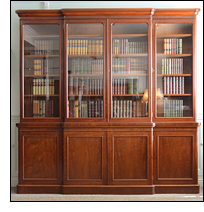 When did people start placing books inside bookcases? Surely, the need for books has always been around? No, not really. Once books were handwritten and they were far rarer than they are today. Books were for the rich, for those who could afford them, who carried them inside expensive and often ornately designed boxes. And this is how your average book would have been stored, inside a box and laid flat, once the title was written across the spine of the book they were then stored upright. Cupboards that stored books then had their doors taken off so the books could be seen and you could pull a book from the shelf. This kind of cupboard design, namely the bookcase is what we have today and it originated from the Middle Ages.
When did people start placing books inside bookcases? Surely, the need for books has always been around? No, not really. Once books were handwritten and they were far rarer than they are today. Books were for the rich, for those who could afford them, who carried them inside expensive and often ornately designed boxes. And this is how your average book would have been stored, inside a box and laid flat, once the title was written across the spine of the book they were then stored upright. Cupboards that stored books then had their doors taken off so the books could be seen and you could pull a book from the shelf. This kind of cupboard design, namely the bookcase is what we have today and it originated from the Middle Ages.
Bookcases were made of oak, many of which still are. Of course you can guarantee Chippendale had to get in on the act and he began creating some beautiful bookcases embellished with all sorts of beautiful designs. He certainly added a certain charm and elegance to what had once been a plain piece of furniture. Now the bookcase was aesthetically pleasing as well as merely serving a function.
Antique Chandeliers
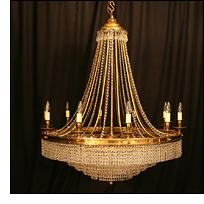 When you walk into a room, usually a grand one, perhaps a stately home, it may have a piano and some expensive but well-worn carpets; there may be some handsome furniture from a bygone era strategically placed in the room’s centre. There may also be the sound of a wall clock and each exquisitely arranged piece of furniture will have its own story. But for me, the real centrepiece of the room will be the chandelier, with the light dancing through the glass creating a its own magical light show, a firework display of multi-coloured lights that light up the room in a way no other form of light can. This ostentatious display of glass is from an era of opulence and wealth; however they come from more humble beginnings.
When you walk into a room, usually a grand one, perhaps a stately home, it may have a piano and some expensive but well-worn carpets; there may be some handsome furniture from a bygone era strategically placed in the room’s centre. There may also be the sound of a wall clock and each exquisitely arranged piece of furniture will have its own story. But for me, the real centrepiece of the room will be the chandelier, with the light dancing through the glass creating a its own magical light show, a firework display of multi-coloured lights that light up the room in a way no other form of light can. This ostentatious display of glass is from an era of opulence and wealth; however they come from more humble beginnings.
The word chandelier comes from the French “chandelle,” which means literally, a light fitting attached to the ceiling. They started out simple enough with wooden beams of wood that formed a cross shape with a spike at each end to hold a candle. By the 16th century the candles they held were made from animal fat otherwise known as tallow. The chandelier’s job was to hold and contain the light from a fixed position, preferably in the ceiling where the light was at a central point in the room.
Antique Desks
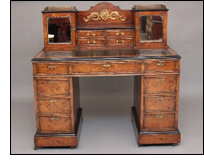 When I think of antique desks I think of Jane Bennett of Pride and Prejudice sitting sedately at a simple yet well-made writing bureau, or perhaps Elinor Dashwood looking out at her sister in the garden while she conducts her business at some polished desk complete with drawers, containing those all-important papers for which to write upon. They seem less important now as we no longer write letters by hand – more’s the pity. However we do still need desks from which to place our laptops and a desk is always an investment, even better if it comes with drawers for there is always something to go in them.
When I think of antique desks I think of Jane Bennett of Pride and Prejudice sitting sedately at a simple yet well-made writing bureau, or perhaps Elinor Dashwood looking out at her sister in the garden while she conducts her business at some polished desk complete with drawers, containing those all-important papers for which to write upon. They seem less important now as we no longer write letters by hand – more’s the pity. However we do still need desks from which to place our laptops and a desk is always an investment, even better if it comes with drawers for there is always something to go in them.
Any contemporary desk may do for some, but alas they haven’t the class or the memories of an older desk from a time gone by, when all your thoughts and dreams would be written on paper and your love would be forever forged in ink on the written page. The workmanship of an antique desk before the mass production techniques we have become accustomed to is something to admire and want, and if an opportunity comes up to purchase one within budget then it’s off to the auctioneers we go, or antique shop perhaps, whichever one has the desk of my dreams.
Antique Picture Frames
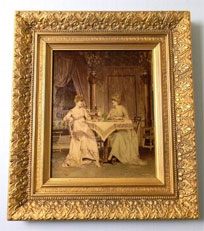 "If a picture paints a thousand words then why can’t I paint you?" Corny, yes? Well as it happens we’re not really talking paintings today, but those beautiful surrounding parts, the bit player in a much bigger picture, known as the frame. You may not always pay much attention to them, however, they always finish a painting or picture off rather well and without them a picture wouldn’t really say very much at all. They may seem little more than the decorative edging surrounding a much more exciting scene within, but they make all the difference.
"If a picture paints a thousand words then why can’t I paint you?" Corny, yes? Well as it happens we’re not really talking paintings today, but those beautiful surrounding parts, the bit player in a much bigger picture, known as the frame. You may not always pay much attention to them, however, they always finish a painting or picture off rather well and without them a picture wouldn’t really say very much at all. They may seem little more than the decorative edging surrounding a much more exciting scene within, but they make all the difference.
It is much easier to frame a picture than it is to frame a painting, especially those paintings where the picture on view extends to the very edge of the canvas. This is known as gallery-wrap. A poster or a picture is a much easier proposition as it can be snipped nicely to fit the frame. You couldn’t quite do that with a Rembrandt.
Antique Silver
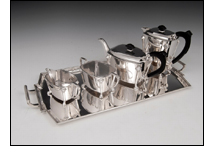 Gandhi once said that health is the real wealth and not gold or silver. There’s a great deal of truth in that, however it’s nice to have some silver or gold too as well as your health, for who can resist a precious metal? Although gold has always been the more expensive metal and the most desired, silver seems to have that little bit more class, a little less shimmer and a bit more glimmer. It is a metal that exudes class and sophistication. It looks good on skin and looks good in whatever shape it has been moulded into, whether it is a simple ashtray or a grand teapot.
Gandhi once said that health is the real wealth and not gold or silver. There’s a great deal of truth in that, however it’s nice to have some silver or gold too as well as your health, for who can resist a precious metal? Although gold has always been the more expensive metal and the most desired, silver seems to have that little bit more class, a little less shimmer and a bit more glimmer. It is a metal that exudes class and sophistication. It looks good on skin and looks good in whatever shape it has been moulded into, whether it is a simple ashtray or a grand teapot.
It has a fine history in that it’s British hallmarking has been with us for over 600 years. From the beginning of the 14th century up until the late 15th an uncrowned leopard’s head adorned most silver in order to identify it from cheap metals. From Edward IV’s reign onwards a date and crowned leopard would be added as a hallmark, and with dated letters it meant that it was easier to date. In the sixteenth century the lion appeared facing left (known as passant guardant) to notify the buyer of its sterling standard, which was 92.5% pure silver. It changed to an uncrowned lion from the mid sixteenth century to the 19th and from 1821 onwards the lion was facing forward (passant).
Antiques and the Future
Hampton Antiques are predominantly known as Specialists in Antique Boxes. We exhibit all over the country at renowned antiques fairs across the UK. We feel it's vital to move with the times: we like to excite the eye and think out of the box to encourage younger antiques collectors and buyers, as well as new customers who may not have considered buying antiques before.
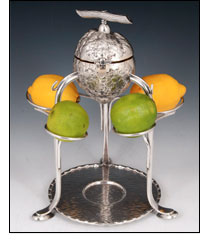 A particular item we have recently purchased represents unique design at its best, has a contemporary look, and adds a splash of colour. Who would have thought it would be Victorian! It's made by Hukin & Heath who were the favoured makers for the wonderful designs of Christopher Dresser. If you want to learn more about your antiques, further a collection or are looking to buy something totally unique, then our advice is to visit one of the many antique exhibitions across the country. Above all, you should like what you buy. If you're unable to make a visit, have a browse through the antiques.co.uk website and remember this famous quote:
A particular item we have recently purchased represents unique design at its best, has a contemporary look, and adds a splash of colour. Who would have thought it would be Victorian! It's made by Hukin & Heath who were the favoured makers for the wonderful designs of Christopher Dresser. If you want to learn more about your antiques, further a collection or are looking to buy something totally unique, then our advice is to visit one of the many antique exhibitions across the country. Above all, you should like what you buy. If you're unable to make a visit, have a browse through the antiques.co.uk website and remember this famous quote:
"A thing is worth what it can do for you, not what you choose to pay for it"
- John Ruskin





